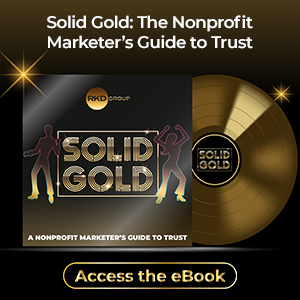For nonprofits, the path between a donor’s question and your mission’s answer is changing fast. Search engines—once reliable funnels of traffic to your website—are increasingly cutting out the middle step.
Google’s AI Overviews summarize content on the results page.
Bing’s Copilot converses with you.
Perplexity compiles tidy briefs.
Apple is preparing Siri to do the same.
Donors and supporters no longer have to click through to learn what you do or why it matters. Nearly 40% of searches now end without a single click.
This shift matters because fundraising depends on both visibility and connection.
If AI pulls your facts but leaves out your story, a potential donor may never see the heart of your mission. If you optimize only for human readers, you risk being invisible in the new answer boxes and voice results.
Welcome to the Dual Web: one layer of engagement for machines, one for people. Let’s talk about what that means for nonprofit fundraising.
A working model: two layers, one system
The challenge—and opportunity—for nonprofits is clear: You must design content that speaks fluently to two audiences at once.
- Humans seek narrative, context and the emotional spark that moves them to act.
- AI systems seek structured, factual and verifiable information they can extract and cite.
To thrive in fundraising’s new landscape, your website has to serve both. The machine layer earns you presence in the answers people see first. The human layer ensures that when someone does click through, they stay, connect and give.
Think of your content as stacked architecture:
- Machine-First Authority (foundation): structured pages rich with verifiable facts—schemas, entities, dates, numbers, FAQs―the content AI can quote with confidence.
- Human-First Engagement (upper level): narrative, imagery and voice that bring those facts to life—impact stories, donor appeals, staff quotes and clear calls to action.
These layers are not in competition; they work in tandem. Authority makes you discoverable. Engagement makes you unforgettable.
How SEO translates in an AI-mediated world
SEO isn’t fading—it’s evolving from “rank to be clicked” to “be trusted to be retrieved.” The mechanics that help links rank also help AIs understand, extract and cite. To help your organization come under AIs’ radar:
- Use schema like scaffolding. Mark up organization details, FAQs, events, articles. For nonprofits, implement the NonprofitOrganization schema on About pages and FAQPage schema where supporters ask common questions. These cues increase answer extraction and voice visibility.
- Write in chunks that snap together. Lead with clear headings (including natural-language questions), short paragraphs and bullets. Offer an opening answer paragraph, then details—a humane inverted pyramid for hurried readers and hungry models.
- State declarative facts with entities. For example, rather than saying, “We have a high graduation rate,” you should state that “92% of students in our program graduated within four years (2025), per state records.” Cover the “who, what, where, when, how” around your cause so thoroughly that an AI has no trouble understanding your domain expertise.
- Tend to the plumbing. Don’t overlook the speed and accessibility of your website. Fast pages, accessible markup, mobile-first layouts and voice-friendly structures matter. Confirm your robots.txt isn’t blocking reputable AI crawlers (e.g., Google’s AI agent, GPTBot). If they can’t crawl, they can’t cite.
Make pages AI-friendly without losing the humanity
Optimizing for machines should never flatten your voice. Design for extraction and elaboration.
- Lead with the answer, layer the story. One-paragraph summary → bullet synopsis of key facts → narrative, quotes and visuals below. Example: “Last year we provided 5,000 meals to families in Houston,” followed by KPIs, then stories of the people who were helped.
- Build Q&A surfaces. Turn your top supporter questions (“How does a $100 donation help?”) into crisp, citable answers across FAQ pages and short video transcripts. Specific beats promotional every time.
- Cite sources and methods. References build human trust and machine confidence. Transparency is a modern ranking signal.
- Stay consistent across the web. Align names, mission statements and numbers on your site, Candid/Charity Navigator, Wikipedia and social profiles. Inconsistencies erode algorithmic trust.
- Keep the people in the room. Credit authors, show credentials, feature program staff, beneficiaries and donors. When someone does click through, the page should reward curiosity and convert intent—newsletter joins, volunteer forms, donations.
Rethink what 'SEO success' means
If answers are delivered before clicks, measurement has to move upstream. It’s not just about organic click-through rates or page-one rankings anymore.
- Track AI citations and mentions. Note appearances in Google AI Overviews, Copilot/Perplexity answers, or voice assistants. Consider this your “AI attribution rate.”
- Watch branded lift and direct visits. If exposure in an AI answer drives more searches for your name or type-in traffic later, that’s impact—just with a curved path.
- Capture assisted conversions. Attribute form fills, newsletter joins and gifts that began with AI discovery, even if the first touch didn’t hit your homepage.
- Log qualitative signals. “I found you on ChatGPT,” or “Siri told me about your program”—these breadcrumbs mark your presence on the zero-click surface.
- Leverage paid search to fill the gaps. Paid search ensures your mission remains visible even when AI overviews reduce organic clicks, while also protecting your brand terms and offering a fast way to test which messages drive the strongest donor response.
Design your content like an architect. Build the foundation machines trust, then craft the spaces where people feel something (and act). In the Dual Web, authority earns the citation, and empathy earns the gift.


.png?width=2000&height=2000&name=image%20(30).png)



Leave a comment: